Podcast: No Dice No Glory Episode 72: Tails of the Sail EP10
The dedicated podcast is back. They guys talk about the new Blood & Plunder Kickstarter and all the cool stuff from Firelock Games
After the jump, you’ll find not only the podcast, but also a written introduction to Blood and Plunder from NDNG’s own Glenn Van Meter
This week Captains Tyler, Tom, and Glenn take a look at what players interested in Blood & Plunder should expect, and where to begin.
First, welcome to the Blood & Plunder! I can honestly say that this is the best community of gamers I’ve ever had the privilege to be a part of. Community members are constantly sharing photos and stories of their games for everyone to see. The players are also all very helpful, with a ton of ideas, suggestions, and advice available all the time on their Facebook group Blood & Plunder – Buccaneering Across the Spanish Main.
If you’re not already aware, Blood & Plunder is a 28mm historical skirmish game based on piracy and buccaneering in the 17th and early 18th century Caribbean. The game is designed to easily transition between land, amphibious, and sea battles, allowing you to play a great variety of skirmish scenarios. While a player’s forces are organized by nationality, each faction within a nationality is very unique and often has access to units from other nationalities as alliances historically tended to be very malleable. The unaligned factions often are able to draw units from several nationalities at the core of their force. This constant mixing of units helps to keep the game balanced, as no nationality gets exclusive access to the “best” units. This same intermingling also makes it easy to grow your collection or start a new force. If you like the look of a unit, there’s likely a way to work them into a list with your current models.
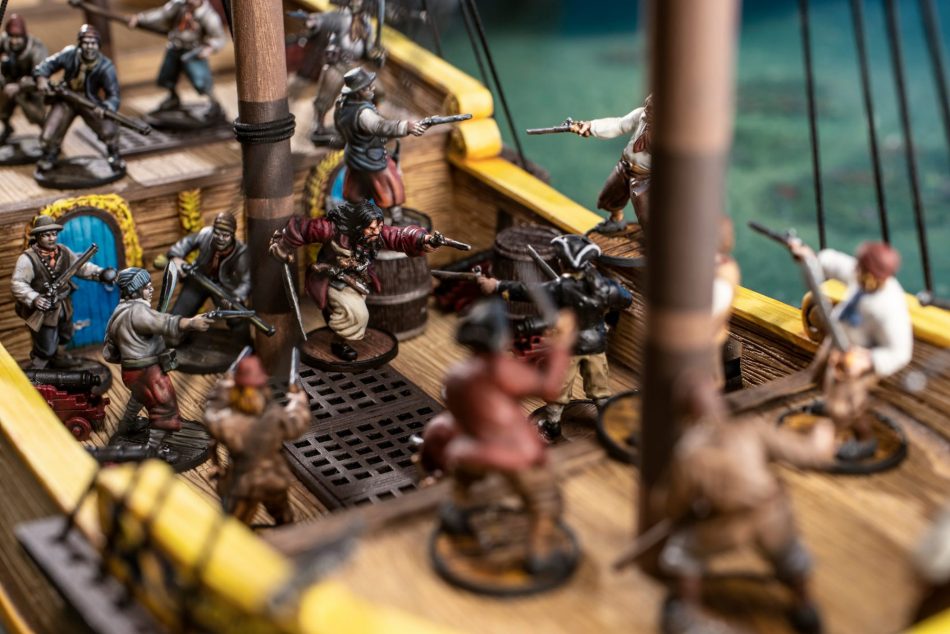
The Basics
Like most miniatures games, there are some basics for Blood & Plunder which all players will need regardless of their faction of choice. The basic requirements are:
*A Measuring Tape
*10-sided (D10) Dice
*Rulebook
*Cards
*Terrain
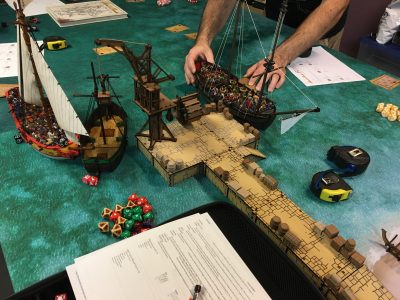
Beginning with the measuring tape, this is one of the easiest things to get. Blood & Plunder uses relatively short ranges, as most games are played on a 4 foot by 4-foot table or smaller. Additionally, ranges are measured in 4” bands, which allows for fairly quick measuring. So, any measuring tape that measures inches will be just fine, including the 3-foot keychain variety.
Blood & Plunder uses the less-common 10-sided die to determine random outcomes, otherwise known as a D10. While not as widely available as the standard 6-sided die (D6), the D10 should easily be available from any store that sells Blood & Plunder. Firelock Games also makes a variety of D10’s which have nationality-specific markings as well as some more generic designs.
The Blood & Plunder rulebook will also be necessary to pay, for obvious reasons The basic rulebook includes French, English, Spanish, and Unaligned faction lists, but more extensive lists are available in the expansion book No Peace Beyond the Line.
The cards needed to play Blood & Plunder are used to determine the order in which players activate units during each turn. Luckily, any standard set of playing cards – including the jokers – can be used for the initiative deck. Much like with the dice, Firelock Games also produces and sells a variety of activation card decks. These purpose-made decks of cards include nationality themed backings and unit activation levels on the face of each card, as well as other markings to show the “speed” of the card suit.
The terrain is potentially both the simplest and biggest hurdle on the list of basics. For sea battles, all that is often needed is a large flat surface, preferably with some kind of blue covering, though having some pieces to mark shallows and shoals would be very helpful. Amphibious and land battles are where the potential for extreme extravagance in your terrain collection For a player starting out, simple solutions like a green sheet with some books under it for hills, book stacks or blocks for buildings, and cut-outs to represent forested areas works great. As players get more into the hobby or more ambitious about the cinematics of their games, they often build or create much more extravagant battlefields, up to hand-crafted buildings, hand-painted palm-trees and harbors of clear resin “water” including underwater detritus and sunken rowboats. But, no need to panic about not having those skills! The community is here to help, and they’re simply something to aspire to.
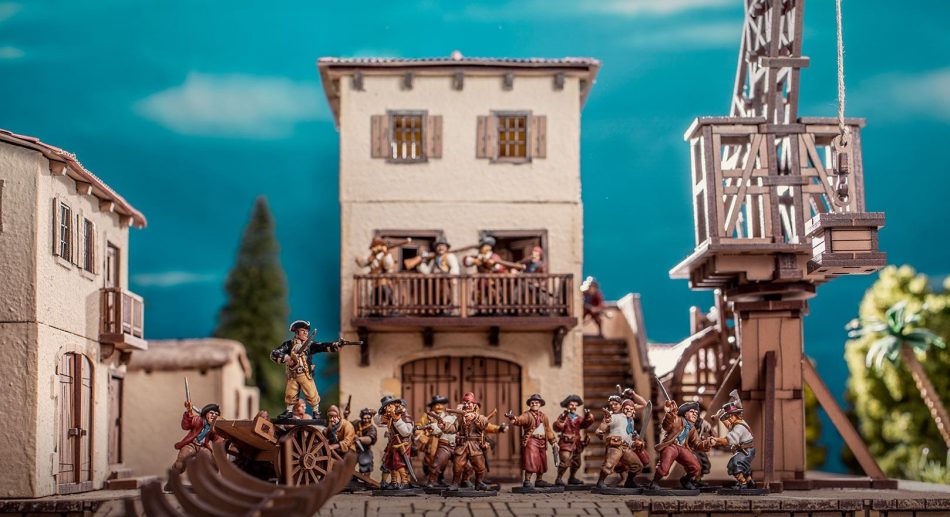
The Forces
As already mentioned, Blood & Plunder factions are organized by nationalities, each of which has their own distinct general “feel”. That is not to say that all factions from a nationality share these traits. The sheer variety of faction choices means that you should be able to find something that fits your style or play preference.
While there are no “bad guys” (let’s face it, all the historical people are bad guys) in Blood & Plunder, the Spanish are kind of like the Empire from Star Wars. They’re everywhere and justifiably engaged in almost any action, but their basic units are fairly mediocre. They have a variety of specialist units that can back up the hordes, and some factions are just the specialized units. Spanish can do some hit and run attacks, and they get bonuses when they work together to overwhelm an enemy unit. They are generally better at melee than shooting and include some units such as the Lanceros who don’t have the option for ranged weapons.
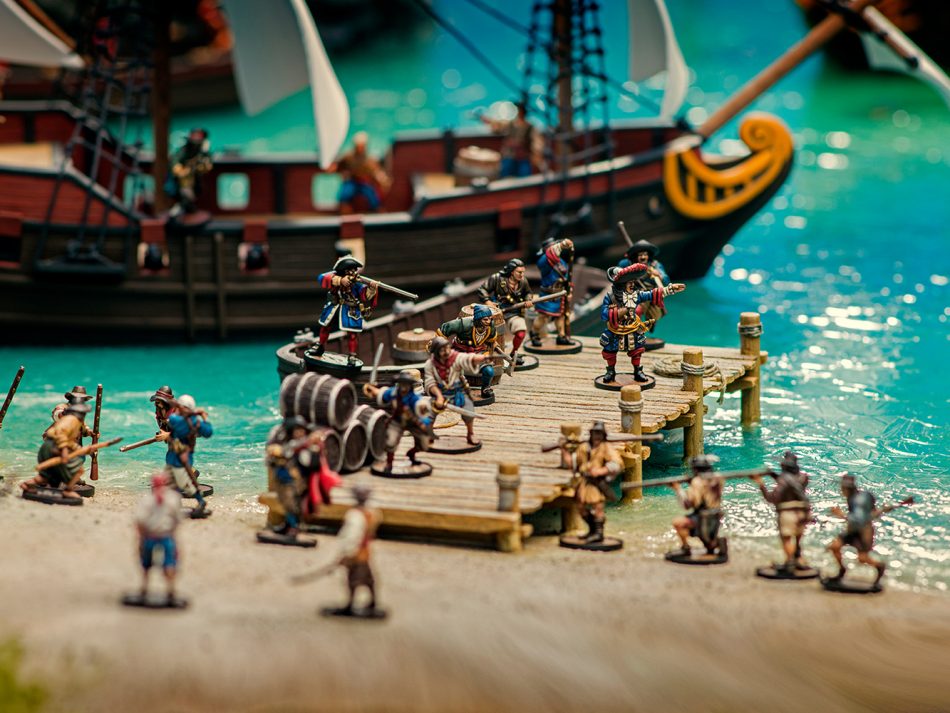
The French forces are essentially the opposite of the Spanish. Their troops tend to be much more specialized and better skilled. However, the French do suffer from poor saves, making them tend to be a bit of a glass cannon. While the Spanish tend to have numbers to overwhelm their foes, the French have more elite troops, and their points reflect that. The best bet with the French is to hit first and hard and try not to get hit back.
The English bring the balance, with a decent mix of skill and survivability. They are the middle-of-the-road choice between the Spanish and the French, but it’s their high morale which often keeps them in the fight. Without the amazing skill of the French or the sheer numbers of the Spanish, the English rely on discipline to win the day.

Unaligned forces represent the true pirates of the Caribbean via the Brethren of the Coast or Logwood Cutters, though other minor European factions such as the Danes or Swedes are also represented by this “nationality”. These are a catch-all group, but they use a variety of units from the other nationalities, allowing you to really cherry-pick the force you want to run. A “European” force is also possible, which usually means well-trained troops, albeit at a slightly higher price.
Dutch are the fourth European powerhouse, added in the first expansion No Peace Beyond the Line. They’re similar to the English but tend towards the elite by virtue of being true masters of the waves. Dutch excel at naval combat as most of their units are either sailors or artillerymen, but they are average troops on land since their sea-faring specialties are no longer useful.
Natives are the second faction added in No Peace Beyond the Line. They mostly cover the southern tribes, though Northern Tribes are being added. These factions focus on hit and run tactics, and use bows much more frequently than muskets or other gunpowder weapons. The combination of special rules and the downsides of bows mean that Natives can be a hard faction for beginners, but can be very rewarding if mastered.
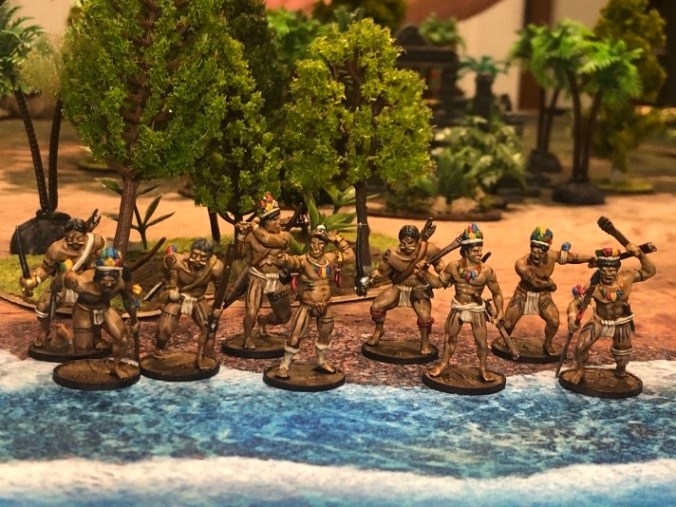
Starter Sets
The Firelock nationality starter sets are all an excellent value. They get you all the basic troop types you need to play a game from a particular nationality. Considering that many land games are played at 100 points and most of the starter sets provide well over that, you often have to cut models out of your list when using the starter sets.
We do recommend against two of the sets for beginners though. The European Militia box and the Pirates and Privateers box (a bit of a misnomer there) are both great values for expanding existing forces but are difficult boxes to use as stand-alone to make a force for a new player. The forces in each don’t easily correspond to a specific faction, but both have a lot of support units that most factions can use. So, once you’ve got some games under your belt and you decide you want larger land games, or you start eyeing an upgrade to a frigate, that would be a good time to purchase the militia or sailors boxes.
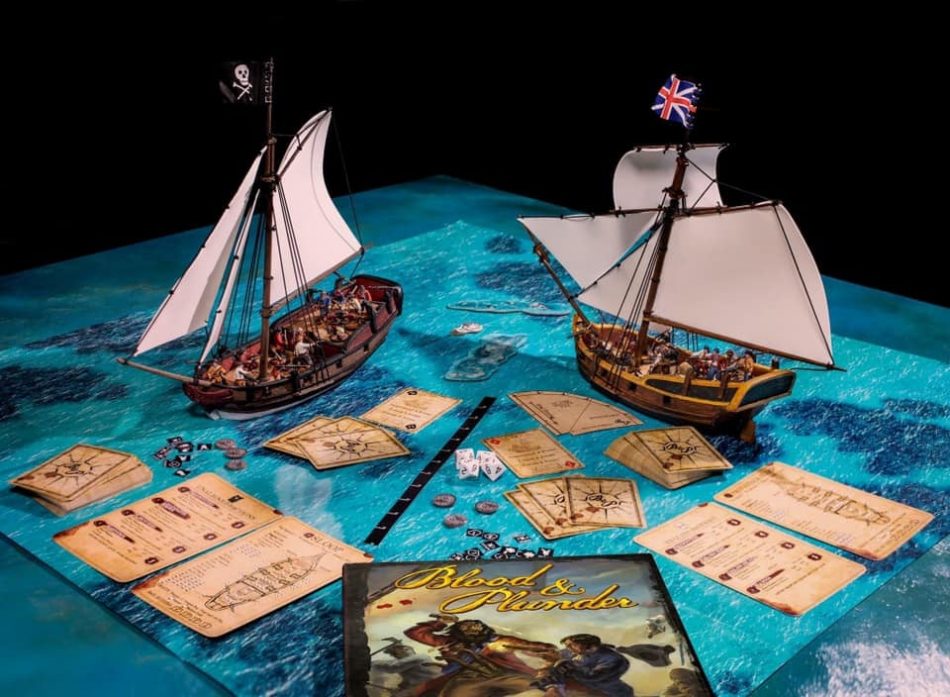
Alternatively, Firelock has completed a Kickstarter for their new Blackbeard vs. Maynard all-plastic 2-player starter set. This set includes all the basics listed in the basics section above, as well as two ships and enough crew to operate both, all for the price of less than two starter sets. This exciting new set should be available in retail in October 2021.
Do I Need a Ship?
Ships are the eye-candy of Blood & Plunder. They are a big reason that many players are drawn to the game. They are also intimidating for many players, but that doesn’t have to be the case. Firelock has a simple but elegant system that effectively treats ships as moving buildings. Most forces can take ships, and there are no minimum requirements for a force to field them. There’s no need to immediately jump for the large 3-masted ships though. A good ship for a beginning player to start with is a sloop or a brig, as they fit well into a typical sea game, and don’t require a lot of extra units to crew. A Bark or a Tartana are also excellent starter options, as their simple design and smaller size make them easy to paint and rig for a new player.
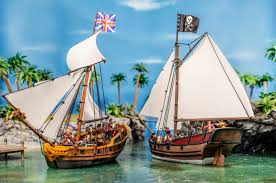
Making a List
One great thing about Firelock Games is just how much they do for their fan base, and this is really shown by the fact that they have constructed and maintain a free online force builder app. Not only is it kept up-to-date, but new units that are being introduced to the game are often included there even before their rules are officially published.
The force builder is easy to use, as players select their nationality, followed by either their faction or commander, then the other. Then adding units is as simple as clicking on the desired unit. Once a unit is added, upgrades can be selected, the model count increased or decreased, and special rules can be read. Characters, boats, ships, and various other options are included as well to be added to the list. If you mistakenly build an illegal list, a big red window pops up to let you know.
Resources
There are a ton of online resources for Blood & Plunder players. Many of these are maintained by Firelock Games, but many are also community-driven sites.
– The main website for Firelock, the Downloads, News, and Community sections all have very useful things ranging from rigging guides to upcoming releases to new scenarios to play.
– Go here to quickly make lists for free – and even print them with all their special rules.
Blood & Plunder – Buccaneering Across the Spanish Main – The community Facebook page was covered before, but contains lots of content and is a great place to look for inspiration as well as clear up any questions you have. Search for them on Facebook.
– This official account has a lot of video content discussing Blood & Plunder, including some video How-to-Play guides.
Firelock Quartermasters – These are players (including the whole Tales of the Sail crew) who work with Firelock and use their experience in the game to assist players and clubs in their areas with everything from running events to tournaments to demos. If there isn’t one at your FLGS, reach out to firelock or the Facebook page to see if there is a Quartermaster in your area.
– A great crew of guys who certainly love the game and even help develop some of the rules, they constantly have new content coming out, including some in-depth analyses of ships, factions, etc. I would also recommend their article if you haven’t read it.
